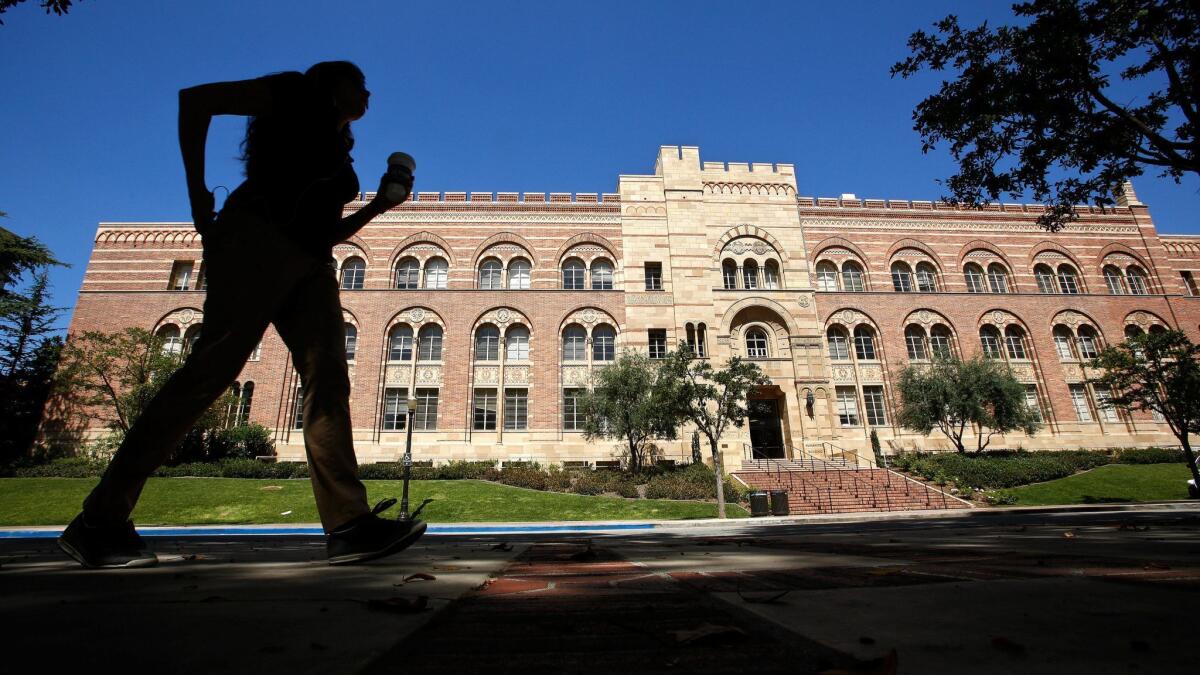Editorial: Tackling low college graduation rates for black and Latino students

It’s depressing how many students start four-year colleges but never finish. Overall, the nationwide graduation rate is about 60%, meaning that six of 10 students who enter college finish within six years. That’s a figure that no one would find acceptable at a public high school. And the figures are substantially worse for black and Latino students, as the achievement gaps that plague education in public schools persist in college. Less than 40% of black students graduate a four-year college within six years, and half of Latino students, according to a 2017 report by the U.S. Department of Education. At some schools, the graduation rates for those groups are in the single digits.
But some colleges consistently beat the average, and education leaders nationwide should be taking a closer look at which schools they are and how they’re doing it. The problem is that until now, no one has put the numbers into an easy-to-compare list.
Alliance College-Ready Public Schools, which operates close to 20 Los Angeles-area charter high schools with a student body that is almost entirely black or Latino, has taken the lead on doing just that. Using 2017 data from the National Center for Education Statistics, it compiled a list of nearly 2,500 colleges, ranked in order of their graduation rates for those two groups of students.
The data certainly don’t appear to support the “mismatch theory,” which holds that affirmative action often leads to bad outcomes for minority students because they end up attending highly selective schools they’re not academically prepared for. In fact, the more selective schools had the highest graduation rates by far for the black and Latino students.
Until now, no one has put the numbers into an easy-to-compare list.
But there was wide variation even among schools with similar student bodies.
Here are a few examples. Almost all black and Latino students at Brown University receive a degree within six years, giving Brown the nation’s highest graduation rate for those groups: 98%. That’s not terribly surprising; Brown is an Ivy League school that attracts extremely talented students with a strong academic bent. It also provides generous financial aid to students who need it — so they’re less likely to drop out for financial reasons.
Students at the iconic Massachusetts Institute of Technology also are among the most accomplished in the country and about 90% of them receive financial aid. Yet the six-year graduation rate for the school’s black and Latino students is significantly lower than Brown’s, at 85%.
Closer to home, and much easier on the wallet, UC Irvine graduates 82% of its black and Latino students. But Cal Poly San Luis Obispo, another selective campus with similarly high-achieving students, graduates only 64%.
The charter organization had a practical purpose for compiling the statistics: It trains its college counselors to guide their high-school seniors toward schools that rank highest on its list, avoiding those with abysmal records of graduating black and Latino students. The numbers range from nearly all to nearly none. Alliance officials say their former students’ college experiences tend to mirror the graduation rates they found for each school.
But there’s a bigger, greater use for such data. Education leaders and government officials should use these figures to launch a deeper examination of why some colleges appear to provide a far more successful college experience for black and Latino students than others do.
The numbers might not necessarily mean that colleges with lower percentages are doing a bad job with those groups. It’s possible that in some cases, colleges expect low graduation rates for all students, not just black and Latino ones. Others may go out of their way to accept students whose records indicate that they’re more likely to make it through the four years, which makes the college look better.
Students who are the first in their family to attend college — more common among black and Latino students — find it especially hard to navigate the experience and are at higher risk of dropping out. They often feel isolated among students with more privileged backgrounds. They may not know how to find a study group or understand how to communicate with professors or put together a course plan. Though they may have excelled in high school, their schools may have done a poor job of preparing them for the more demanding work of college. And even with generous scholarships, the financial burden might be more than they and their families can handle.
There are meaningful ways that colleges can improve these students’ chances.
Some colleges have been working on this problem for years. UC Irvine, for example, consistently ranks among the top nationally for its graduation rates among Pell grant recipients, who come from low-income backgrounds. (UC campuses in general rank among the best on this score.) Black and Latino students receive such grants at much higher rates than white or Asian students.
UCI holds social events for first-generation students so that they find they’re not alone. It helps them find and form study groups, has graduate students help them with course schedules and study skills, and connects them with faculty members who were the first in their own families to attend college.
Enter the Fray: First takes on the news of the minute from L.A. Times Opinion »
Summer bridge programs at UC campuses introduce incoming freshmen to life at their new school so that they can start their classes informed, prepared and more confident.
Colleges that have run these kinds of programs find that they make a real difference.
Low college graduation rates leave a lot of dreams dashed, money wasted and college loans outstanding without the higher income of a college degree to help pay them off. They also mean that many young people aren’t getting the education necessary to make the United States a leader in the fastest-growing, higher-paying fields that will strengthen the economy. And when the numbers are so much lower for black and Latino students, it means that educational and economic gaps are being perpetuated.
Although Alliance compiled its rankings from public data, its own list is proprietary. Nevertheless, a public agency — say, the U.S. Department of Education — could easily pull together a similar list online that allows everyone to see these differences in graduation rates. Perhaps that would put pressure on colleges to compare their performance with competing institutions, and consider what measures they can take to graduate more of the students who come to them with such high hopes.
Follow the Opinion section on Twitter @latimesopinionand Facebook
More to Read
A cure for the common opinion
Get thought-provoking perspectives with our weekly newsletter.
You may occasionally receive promotional content from the Los Angeles Times.










